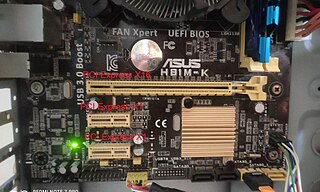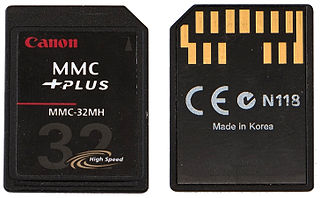
A hard disk drive (HDD), hard disk, hard drive, or fixed disk is an electro-mechanical data storage device that stores and retrieves digital data using magnetic storage with one or more rigid rapidly rotating platters coated with magnetic material. The platters are paired with magnetic heads, usually arranged on a moving actuator arm, which read and write data to the platter surfaces. Data is accessed in a random-access manner, meaning that individual blocks of data can be stored and retrieved in any order. HDDs are a type of non-volatile storage, retaining stored data when powered off. Modern HDDs are typically in the form of a small rectangular box.

A motherboard is the main printed circuit board (PCB) in general-purpose computers and other expandable systems. It holds and allows communication between many of the crucial electronic components of a system, such as the central processing unit (CPU) and memory, and provides connectors for other peripherals. Unlike a backplane, a motherboard usually contains significant sub-systems, such as the central processor, the chipset's input/output and memory controllers, interface connectors, and other components integrated for general use.

Flash memory is an electronic non-volatile computer memory storage medium that can be electrically erased and reprogrammed. The two main types of flash memory, NOR flash and NAND flash, are named for the NOR and NAND logic gates. Both use the same cell design, consisting of floating gate MOSFETs. They differ at the circuit level depending on whether the state of the bit line or word lines is pulled high or low: in NAND flash, the relationship between the bit line and the word lines resembles a NAND gate; in NOR flash, it resembles a NOR gate.

PCI Express, officially abbreviated as PCIe or PCI-e, is a high-speed serial computer expansion bus standard, designed to replace the older PCI, PCI-X and AGP bus standards. It is the common motherboard interface for personal computers' graphics cards, capture cards, sound cards, hard disk drive host adapters, SSDs, Wi-Fi, and Ethernet hardware connections. PCIe has numerous improvements over the older standards, including higher maximum system bus throughput, lower I/O pin count and smaller physical footprint, better performance scaling for bus devices, a more detailed error detection and reporting mechanism, and native hot-swap functionality. More recent revisions of the PCIe standard provide hardware support for I/O virtualization.

SATA is a computer bus interface that connects host bus adapters to mass storage devices such as hard disk drives, optical drives, and solid-state drives. Serial ATA succeeded the earlier Parallel ATA (PATA) standard to become the predominant interface for storage devices.

Western Digital Corporation is an American data storage company headquartered in San Jose, California. It has a decades-long history in the electronics industry as an integrated circuit and data memory technology developer. It is one of the world’s largest computer hard disk drive (HDD) manufacturers, along with producing solid-state drives (SSDs) and flash memory devices.

MultiMediaCard, officially abbreviated as MMC, is a memory card standard used for solid-state storage. Unveiled in 1997 by SanDisk and Siemens, MMC is based on a surface-contact low-pin-count serial interface using a single memory stack substrate assembly, and is therefore much smaller than earlier systems based on high-pin-count parallel interfaces using traditional surface-mount assembly such as CompactFlash. Both products were initially introduced using SanDisk NOR-based flash technology.
Input/output operations per second is an input/output performance measurement used to characterize computer storage devices like hard disk drives (HDD), solid state drives (SSD), and storage area networks (SAN). Like benchmarks, IOPS numbers published by storage device manufacturers do not directly relate to real-world application performance.

A solid-state drive (SSD) is a type of solid-state storage device that uses integrated circuits to store data persistently. It is sometimes called semiconductor storage device, solid-state device, and solid-state disk.
SandForce was an American fabless semiconductor company based in Milpitas, California, that designed flash memory controllers for solid-state drives (SSDs). On January 4, 2012, SandForce was acquired by LSI Corporation and became the Flash Components Division of LSI. LSI was subsequently acquired by Avago Technologies on May 6, 2014 and on the 29th of that same month Seagate Technology announced its intention to buy LSI's Flash Components Division.
NVM Express (NVMe) or Non-Volatile Memory Host Controller Interface Specification (NVMHCIS) is an open, logical-device interface specification for accessing a computer's non-volatile storage media usually attached via the PCI Express bus. The initial NVM stands for non-volatile memory, which is often NAND flash memory that comes in several physical form factors, including solid-state drives (SSDs), PCIe add-in cards, and M.2 cards, the successor to mSATA cards. NVM Express, as a logical-device interface, has been designed to capitalize on the low latency and internal parallelism of solid-state storage devices.

M.2, pronounced m dot two and formerly known as the Next Generation Form Factor (NGFF), is a specification for internally mounted computer expansion cards and associated connectors. M.2 replaces the Mini SATA (mSATA) standard and the Mini PCIe (mPCIe) standard. Employing a more flexible physical specification, M.2 allows different module widths and lengths, which, paired with the availability of more advanced interfacing features, makes M.2 more suitable than mSATA in general for solid-state storage applications, particularly in smaller devices such as ultrabooks and tablets.

SATA Express is a computer bus interface that supports both Serial ATA (SATA) and PCI Express (PCIe) storage devices, initially standardized in the SATA 3.2 specification. The SATA Express connector used on the host side is backward compatible with the standard SATA data connector, while it also provides two PCI Express lanes as a pure PCI Express connection to the storage device.
Solid-state storage (SSS) is non-volatile computer storage that has no moving parts; it uses only electronic circuits. This solid-state design dramatically differs from the commonly-used competing technology of electromechanical magnetic storage which uses moving media coated with magnetic material. Generally, SSS is much faster but more expensive for the same amount of storage.
In an enterprise server, a Caching SAN Adapter is a host bus adapter (HBA) for storage area network (SAN) connectivity which accelerates performance by transparently storing duplicate data such that future requests for that data can be serviced faster compared to retrieving the data from the source. A caching SAN adapter is used to accelerate the performance of applications across multiple clustered or virtualized servers and uses DRAM, NAND Flash or other memory technologies as the cache. The key requirement for the memory technology is that it is faster than the media storing the original copy of the data to ensure performance acceleration is achieved.

U.2, using the port SFF-8639, is a computer interface standard for connecting solid-state drives (SSDs) to a computer. It covers the physical connector, electrical characteristics, and communication protocols.
Virtium Solid State Storage and Memory is a privately held American company that manufactures semiconductor memory and solid-state disk (SSD) products for data storage in industrial/machine-to-machine designs, embedded systems, including small-footprint designs, and Industrial Internet of Things (IIoT) applications. The company's primary markets of focus include defense, industrial systems, network communications, and transportation. The name Virtium is derived from the word virtue.
In-situ processing also known as in-storage processing (ISP) is a computer science term that refers to processing data where it resides. In-situ means "situated in the original, natural, or existing place or position." An in-situ process processes data where it is stored, such as in solid-state drives (SSDs) or memory devices like NVDIMM, rather than sending the data to a computer's central processing unit (CPU).
IBM FlashCore Modules (FCM) are solid state technology computer data storage modules using PCI Express attachment and the NVMe command set. They are offered as an alternative to industry-standard 2.5" NVMe SSDs in selected arrays from the IBM FlashSystem family, with raw storage capacities of 4.8 TB, 9.6 TB, 19.2 TB and 38.4 TB. FlashCore modules support hardware self-encryption and real-time inline hardware data compression up to 115.2 TB address space, without performance impact.










